Author: Alex Xu
After experiencing the bull and bear market cycle from 2020 to 2023, we found that in the Web3 business world, the only truly established business model in the application layer is still DeFi. Dex, lending, and stablecoins are still the three cornerstones of DeFi (the derivatives track has also seen significant development in recent years), and even in a bear market, their business remains resilient.
Mint Ventures has previously written numerous research reports and analytical articles on Dex and stablecoins, including projects such as Curve, Trader Joe, Syncswap, Izumi, and Velodrome in the Dex category, and projects like MakerDao, Frax, Terra, Liquity, Angle, and Celo in the stablecoin category. This issue of Clips will return its focus to the lending track, with a particular emphasis on the emerging force, Morpho, whose business data has seen rapid growth in the past year.
In this article, the author will review Morpho's existing business and the recently announced lending infrastructure service, Morpho Blue, and attempt to answer the following questions:
- What is the current market landscape of the lending track?
- What businesses does Morpho include, and what problems does it attempt to solve? How is the current business development progressing?
- What are the prospects of the newly launched Morpho Blue service, and will it impact the leading positions of Aave and Compound? What other potential impacts are there?
Decentralized Lending Market Landscape
Organic demand becomes mainstream, Ponzi scheme colors fade
The decentralized lending's capital capacity has always ranked at the forefront, and currently, TVL has surpassed Dex, becoming the track with the largest capital capacity in the DeFi field.

Source: https://defillama.com/categories
Decentralized lending is also one of the rare business categories in the Web3 field that has achieved "PMF" (Product-Market Fit). Although during the DeFi summer boom in 2020-2021, there were many projects that heavily subsidized lending behavior through tokens, such phenomena have greatly reduced in the bear market.
As shown in the following chart, the protocol revenue of the leading lending project Aave has exceeded its token incentives since December 2022, far surpassing token incentives (protocol revenue in September was $1.6 million, while Aave token incentives were $230,000). Furthermore, Aave's token incentives are mainly used to encourage token holders to stake Aave to ensure sufficient compensation in case of protocol defaults and treasury insufficiency, rather than to incentivize user deposit and borrowing behavior. Therefore, Aave's current deposit and borrowing behavior is completely "organic," rather than supported by liquidity mining-based Ponzi structures.
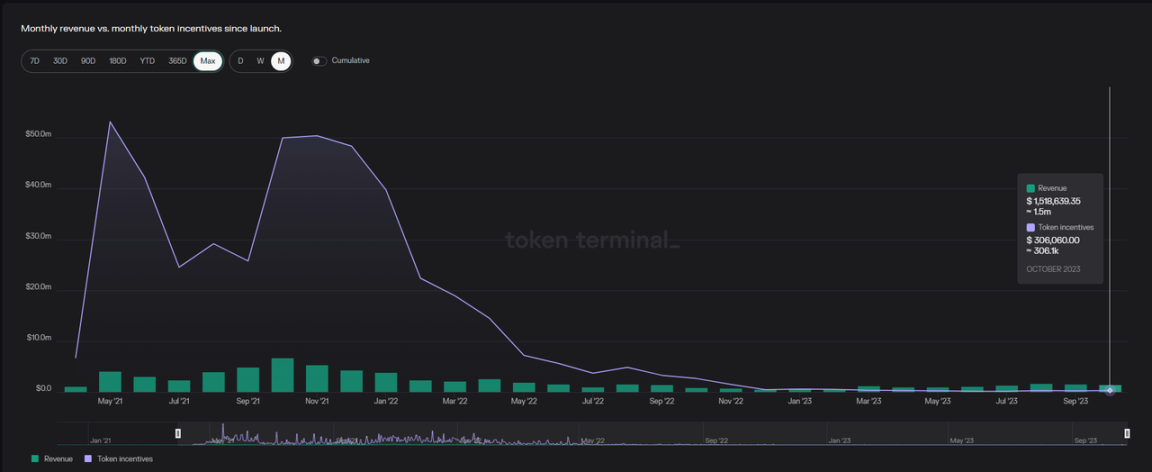
Monthly comparison of Aave's incentive collection and protocol revenue, source: https://tokenterminal.com/
In addition, the leading lending protocol Venus on the BNBchain also achieved a benign operation of protocol revenue surpassing incentive collection after March 2023, and it has also basically stopped subsidizing deposit and borrowing behavior.
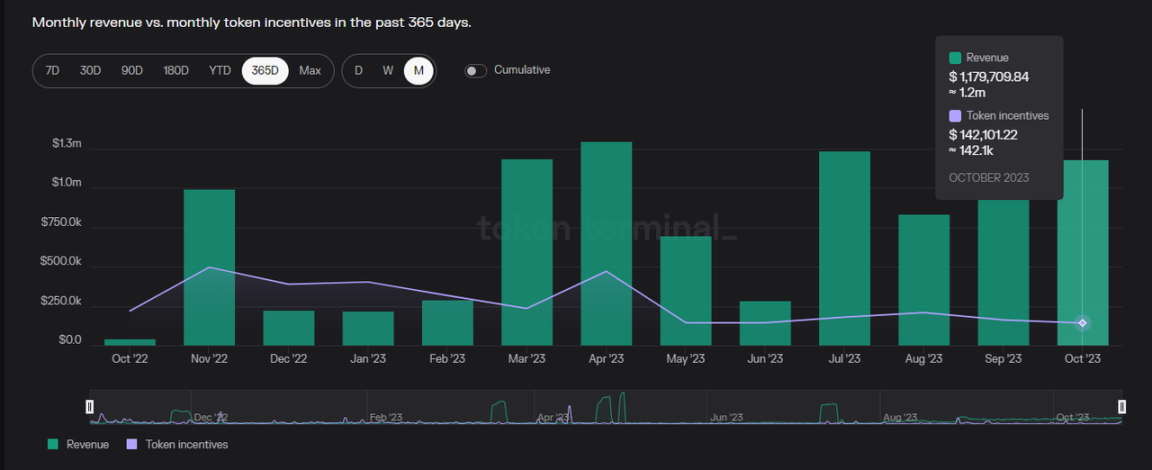
Monthly comparison of Venus's incentive collection and protocol revenue, source: https://tokenterminal.com/
However, many lending protocols still have high token subsidies behind supply and demand, where the value of protocol subsidies for lending behavior far exceeds the income obtained from it.
For example, Compound V3 still provides Comp token subsidies for deposit and borrowing behavior.
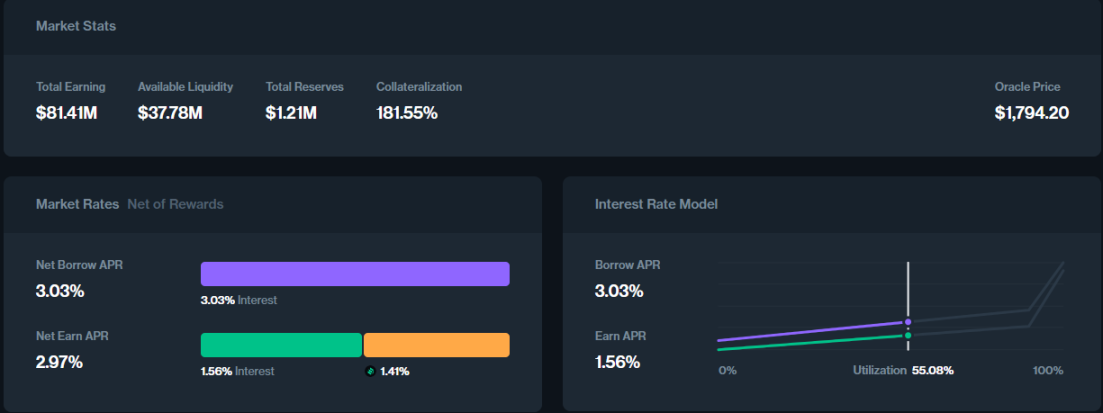
Compound V3 provides nearly half of the USDC deposit rate on the Ethereum mainnet through token subsidies, source: https://app.compound.finance/markets/weth-mainnet
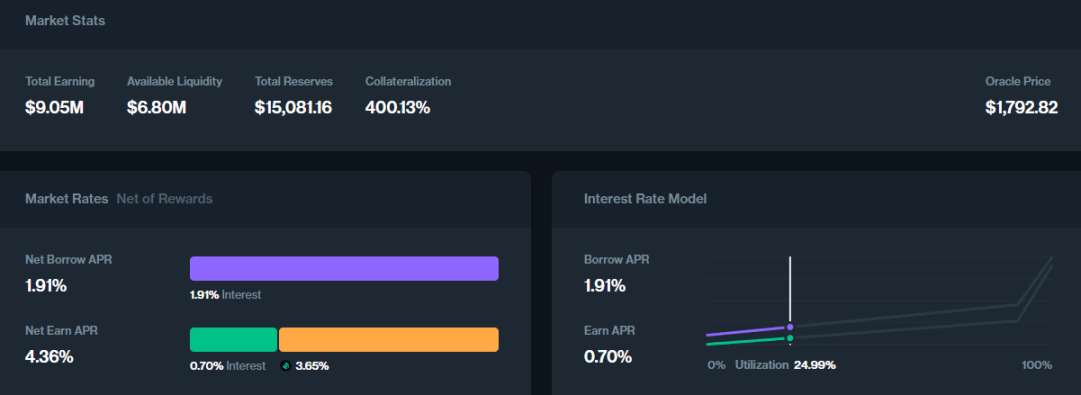
84% of the USDC deposit rate on Compound V3 Base on the Ethereum mainnet is provided by token subsidies, source: https://app.compound.finance/markets/weth-basemainnet
If Compound is maintaining its market share through high token subsidies, then another protocol, Radiant, is purely a Ponzi structure.
On Radiant's lending market page, we can see two unusual phenomena:
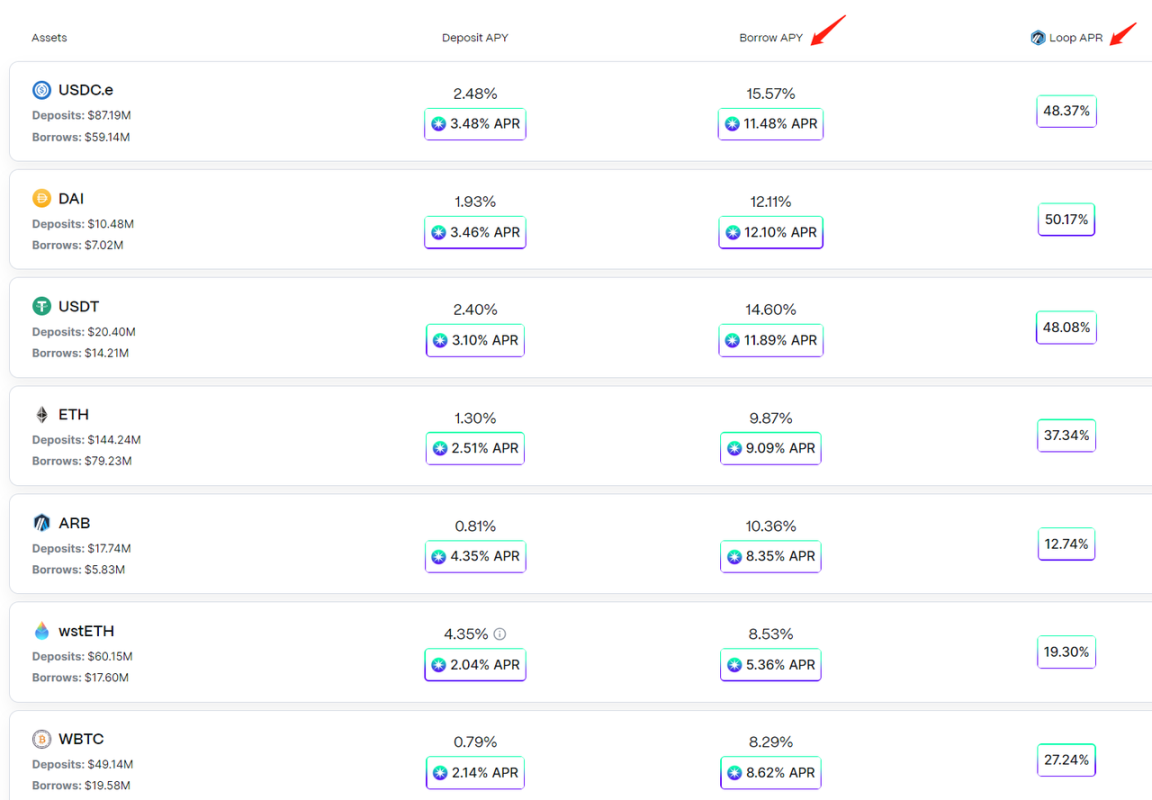
Source: https://app.radiant.capital/
First, its asset lending rates are significantly higher than market rates. The stablecoin lending rates in mainstream currency markets are usually around 3-5%, while Radiant's rates are as high as 14-15%, and the lending rates for other assets are 8-10 times higher than those in mainstream currency markets;
Second, its product interface primarily promotes circular lending, encouraging users to repeatedly use the same asset as collateral for deposits and borrowing: the operation of depositing and borrowing, to amplify their "total deposit and borrowing amount" in order to maximize the mining income of the platform's token, Radiant. Essentially, the Radiant project is indirectly selling its project token, RDNT, to users through the collection of borrowing fees.
However, the problem is that the source of Radiant's fees—user borrowing behavior—is not based on genuine organic lending demand, but rather to obtain the RNDT token. This constitutes a "robbing Peter to pay Paul" Ponzi economic structure. In this process, the lending platform does not have genuine "financial consumers." Circular lending is not a healthy lending model because the depositors and borrowers of the same asset are the users themselves, and the economic source of RDNT dividends also comes from the users themselves. The only risk-free beneficiary is the platform project party that extracts profits from the fees (it takes 15% of interest income). Although the project party has delayed the short-term death spiral pressure of the RDNT token through the dLP collateral mechanism, in the long run, unless Radiant gradually shifts its business from a Ponzi structure to a normal business model, the death spiral will eventually come.
However, overall, the decentralized lending market, represented by leading projects like Aave, is gradually moving away from relying on high subsidies to sustain operating income and returning to a healthy business model.
The following chart shows the changes in the active loan volume in the web3 lending market from May 2019 to October 2023, from the initial hundreds of thousands of dollars, to the peak of $22.5 billion in November 2021, to the low of $3.8 billion in November 2022, and now at $5 billion. The lending market's business volume is slowly bottoming out and rebounding, demonstrating good business resilience even in a bear market.
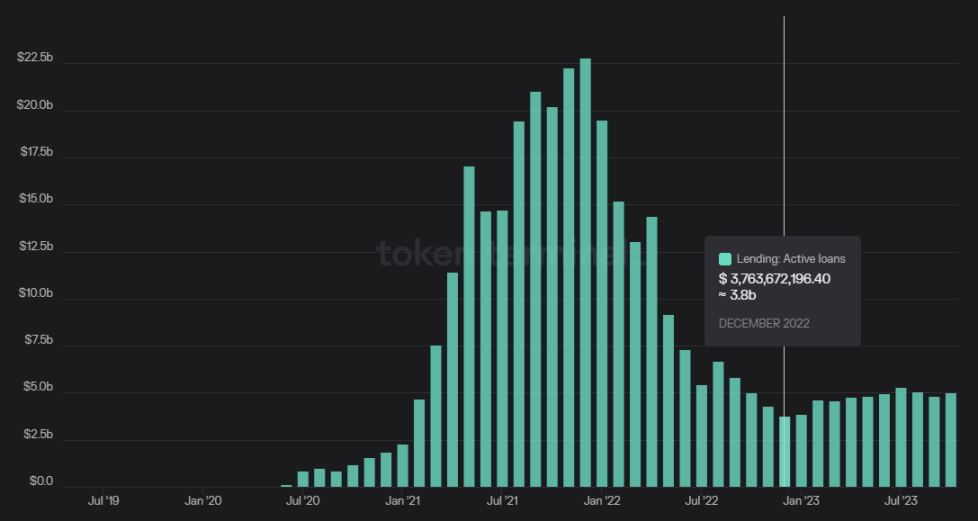
Source: https://tokenterminal.com/terminal/markets/lending
Obvious Moat, High Market Concentration
As part of the DeFi infrastructure, compared to the fierce competition in the Dex market, the leading projects in the lending track have a stronger moat, specifically reflected in:
1. More stable market share. The chart below shows the changes in the active lending volume share of various projects from May 2019 to October 2023. Since Aave's strong performance in mid-2021, its market share has remained stable in the range of 50-60%, while the second-place Compound, although its share has been squeezed, still maintains a relatively stable ranking.
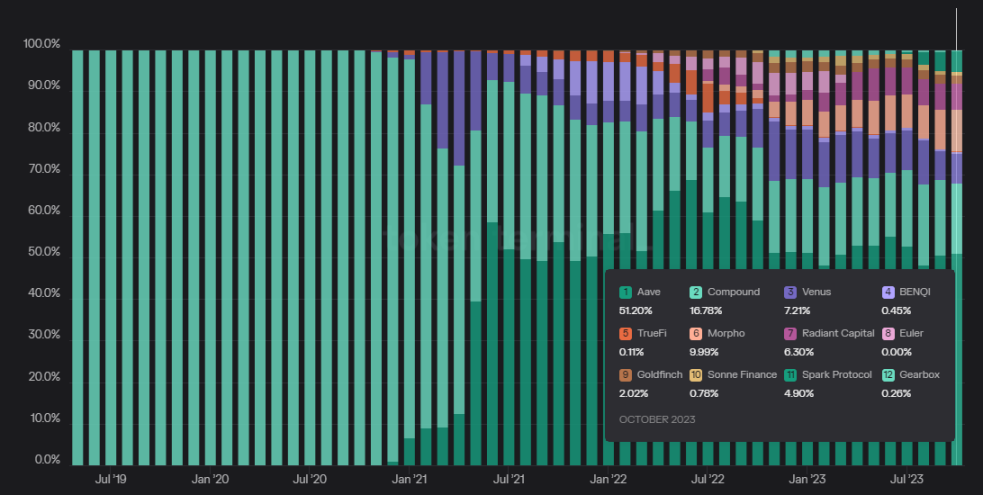
Source: https://tokenterminal.com/terminal/markets/lending
In contrast, the market share changes in the Dex track are more drastic. After quickly capturing nearly 90% of the trading volume market share following its launch, the market share of the leading project Uniswap dropped to 37% due to the rapid growth of Sushiswap, Curve, and Pancakeswap, but has now returned to around 55%. Additionally, the number of projects in the Dex track is much higher than in the lending track.
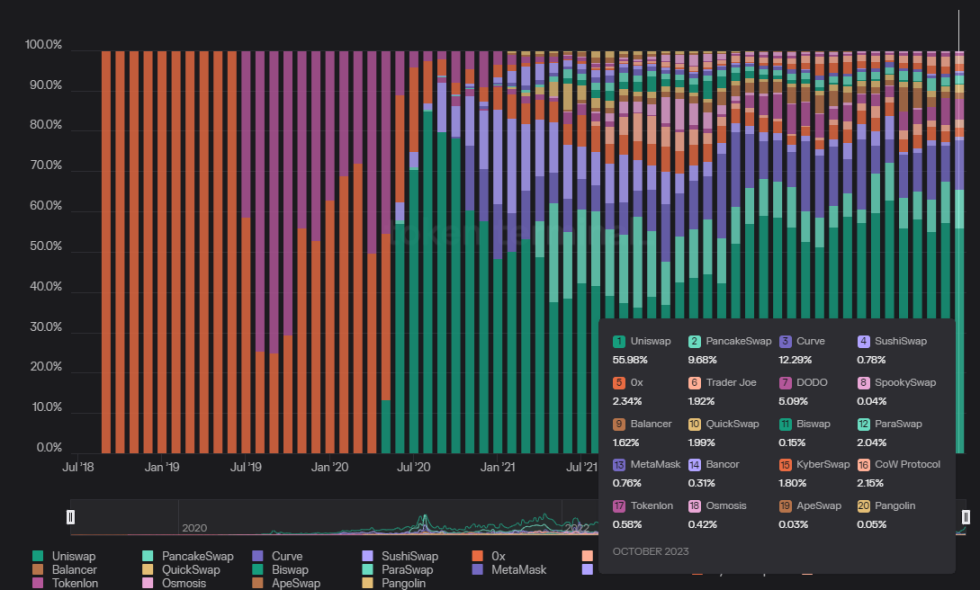
Source: https://tokenterminal.com/terminal/markets/lending
2. Stronger profitability of lending track projects. As mentioned in the previous section, projects like Aave have been able to achieve positive cash flow without subsidizing lending behavior, with monthly interest spread revenue of around $1.5-2 million. In contrast, most Dex projects, either like Uniswap that has not yet started charging at the protocol level (only frontend fees), or have token emissions for liquidity incentives that far exceed protocol fee income, are operating at a loss in practice.
The moat of leading lending protocols can be broadly summarized as brand strength in security, which can be further broken down into the following 2 points:
Long-standing history of secure operations: Since the DeFi Summer in 2020, there have been numerous Aave or Compound fork projects launched on various chains, but most of them have suffered from theft or significant bad debt losses shortly after establishment. Aave and Compound have not experienced serious theft or unsustainable bad debt incidents so far. This long-term record of secure operation in a real network environment is the most important security endorsement for depositors. New lending protocols may have more attractive concepts and higher short-term APY, but it is difficult to gain the trust of users, especially whale users, without years of baptism.
More abundant security budget: Leading lending protocols have higher business income and relatively ample treasury funds, which provide a substantial budget for security audits and asset risk control. This is crucial for the development of new features and the introduction of new assets in the future.
Overall, lending is a market that has proven to have organic demand, a healthy business model, and relatively concentrated market share.
Business Content and Operational Status of Morpho
Business Content: Interest Rate Optimization
Morpho's current online business is a peer-to-peer lending protocol (or interest rate optimizer) built on top of Aave and Compound. Its role is to improve the inefficiency of funds in Aave's pool lending protocol due to the mismatch between deposit and borrowing funds.
Its value proposition is simple and clear: to provide better interest rates for both depositors and borrowers, i.e., higher deposit returns and lower borrowing rates.
The inefficiency issue in Aave and Compound's pool model is due to the mechanism that determines that the total size of deposit funds (pool) is always greater than the total size of lending funds (points). In most cases, the USDT currency market has a total deposit of 10 billion, but only 6 billion USDT is borrowed.
For depositors, because the idle 4 billion funds also have to share the interest generated by the 6 billion borrowed, the interest each person can receive is reduced. For borrowers, although only a portion of the pool funds is borrowed, they are actually paying interest for the entire pool. This mismatch causes the problem of deposit and borrowing funds.
Using the interest rate optimizer module on Aave V2, which currently has the largest deposit volume for Morpho, let's see how Morpho's interest rate optimization service solves this problem.
- Deposits: Depositor BOB deposits 10,000 Dai into Morpho, and Morpho will first deposit the funds into Aave V2's currency market, with a deposit interest rate of 3.67% based on Aave's market rate
- Borrowing collateral: Borrower ALICE first deposits 20 ETH as collateral into Morpho and requests to borrow 10,000 Dai. Morpho will deposit the collateral into Aave V2's currency market
- Deposit and borrowing matching: Then, Morpho retrieves the 10,000 Dai previously deposited by BOB into Aave, directly matching it to lend to ALICE. At this point, BOB's deposit and ALICE's borrowing are fully matched, BOB's deposit is not idle and is fully lent out, and ALICE only pays interest for the 10,000 Dai borrowed, not the entire pool. Therefore, in this matching scenario, BOB receives a deposit interest rate of 4.46%, higher than the 3.67% in Aave's pool model, and ALICE pays a lower borrowing interest rate of 4.46%, compared to the 6.17% in Aave's pool model. Both parties' interest rates are optimized.
* Note: Whether the 4.46% P2P interest rate in the example is closer to the lower limit (deposit APY) or upper limit (borrowing APY) of the underlying protocol depends on Morpho's parameters, which are determined by governance
- Mismatch resolution: Suppose at this point BOB wants to withdraw the previously lent Dai, and ALICE has not yet repaid the money. In the absence of other lenders on Morpho, Morpho will borrow 10,000+ Dai in principal and interest from Aave using ALICE's 20 ETH as collateral, and provide it to BOB for redemption
- Matching order: Considering gas costs, the P2P matching of deposit and borrowing funds is "matching large funds first," with larger funds being matched first. This reduces the proportion of gas consumption per unit of funds. If the gas consumption value of executing the matching is too high relative to the matched fund amount, the matching will not be executed to avoid excessive wear and tear.
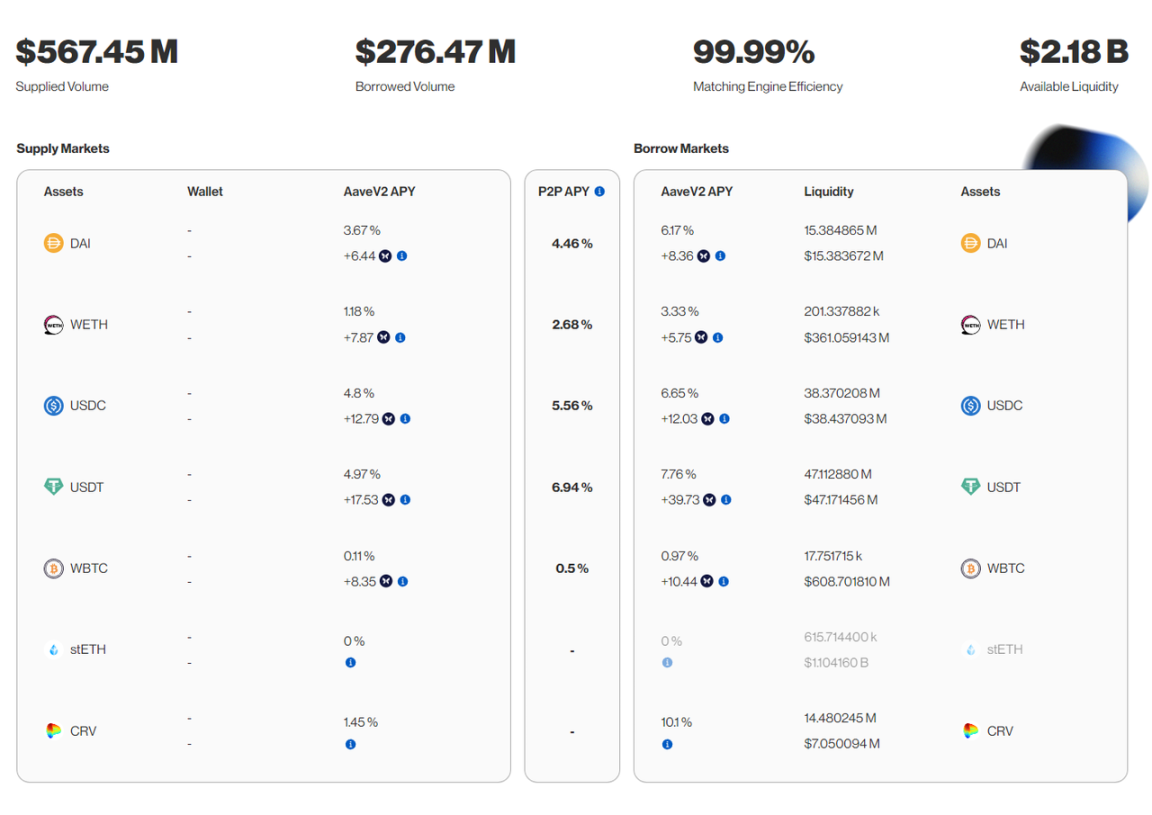
Source: https://aavev2.morpho.org/?network=mainnet
Through the above explanation, we find that Morpho's business essentially uses Aave and Compound as capital buffer pools to provide interest rate optimization services through matching for depositors and borrowers.
The cleverness of this design lies in attracting user funds through the composability of the DeFi world. For users, the attraction lies in:
1. At the very least, they can obtain financial rates equivalent to Aave and Compound on Morpho, and when matching occurs, their returns/costs will be significantly optimized.
2. Morpho's products are mainly built on Aave and Compound, and the risk parameters are fully replicated and executed, with its funds also allocated in Aave and Compound, thus inheriting the brand reputation of the two established protocols to a great extent.
This clever design and clear value proposition have allowed Morpho to achieve a deposit volume of nearly $1 billion in just over a year, ranking second only to Aave and Compound based on data.
Business Data and Token Situation
Business Data
The chart below shows the business trends of Morpho's total deposits (blue line), total borrowings (light brown line), and matched amounts (dark brown).
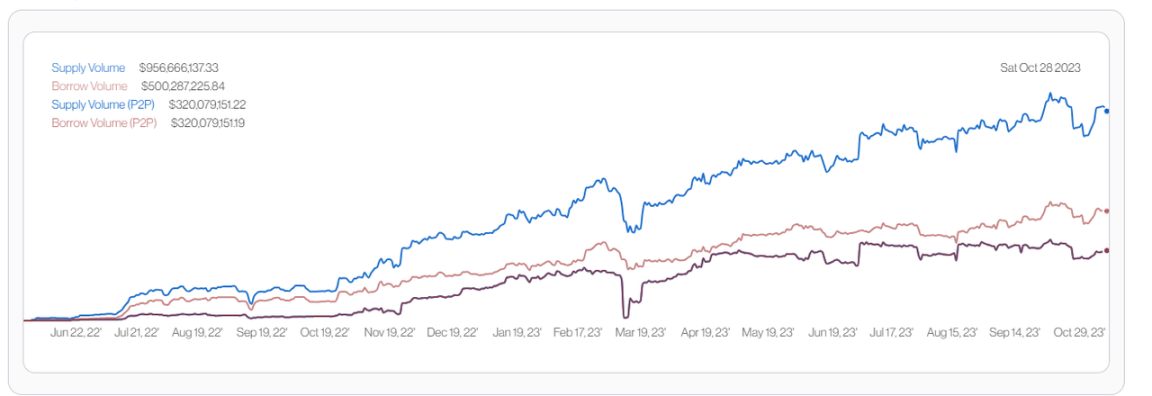
Source: https://analytics.morpho.org/
Overall, the various business scales of Morpho continue to grow, with a deposit fund matching rate of 33.4% and a borrowing fund matching rate of 63.9%, which is quite impressive.
Token Situation
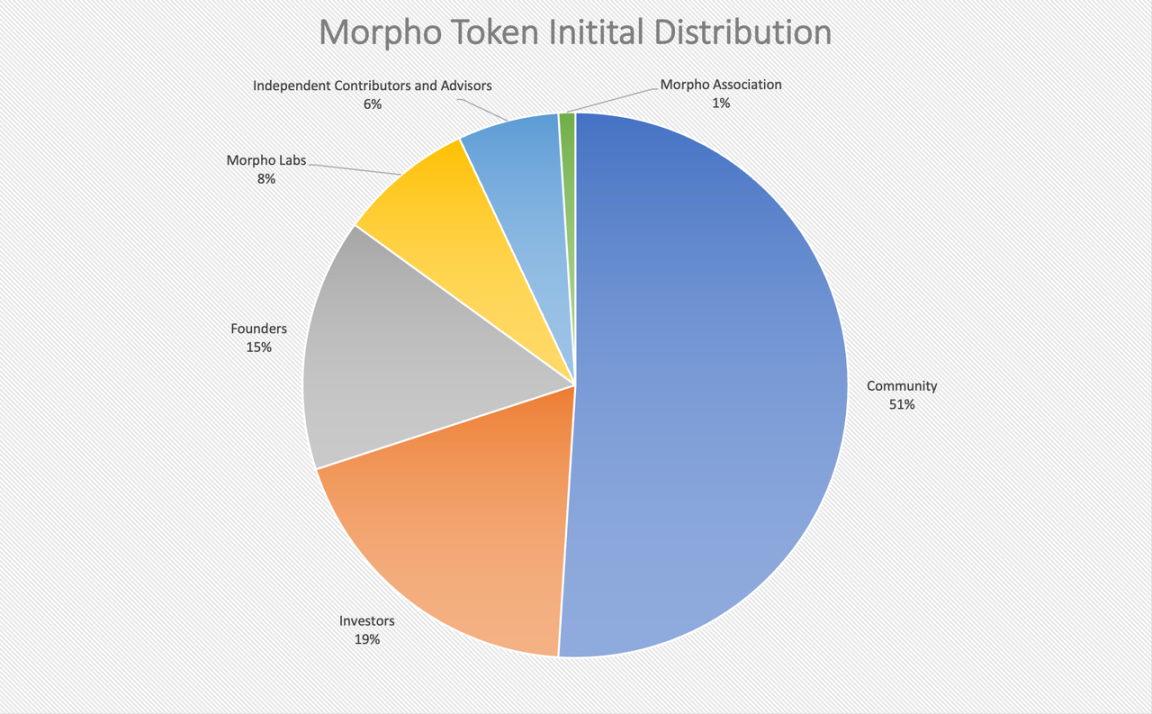
Source: Official Documentation
The total supply of Morpho tokens is 1 billion, with 51% allocated to the community, 19% sold to investors, and the founders and the development company Morpho Labs and the operating organization Morpho Association owning 24%, with the remaining portion allocated to advisors and contributors.
It is worth mentioning that although Morpho tokens have been issued and used in voting decisions and project incentives, they are currently non-transferable. Therefore, they do not have a secondary market price, and users and investors who receive tokens can participate in governance but cannot sell them.
Unlike projects like Curve, which have hardcoded token emission and incentive mechanisms, Morpho's token incentives are batched and determined on a quarterly or monthly basis, allowing the governance team to flexibly adjust the intensity and specific strategies of incentives based on market changes.
In my opinion, this is a more practical approach and may become the mainstream model for token incentive distribution in the future Web3 business.
In terms of incentive targets, Morpho incentivizes both deposit and borrowing behaviors. However, the allocation of Morpho tokens in incentives is currently not significant, with only 30.8 million tokens allocated in the past year, accounting for 3.08% of the total supply. Additionally, based on the incentive periods and corresponding token allocations in the chart below, the official token expenditure on incentives is rapidly decreasing, and the reduction in expenditure has not slowed down the growth of Morpho's business.
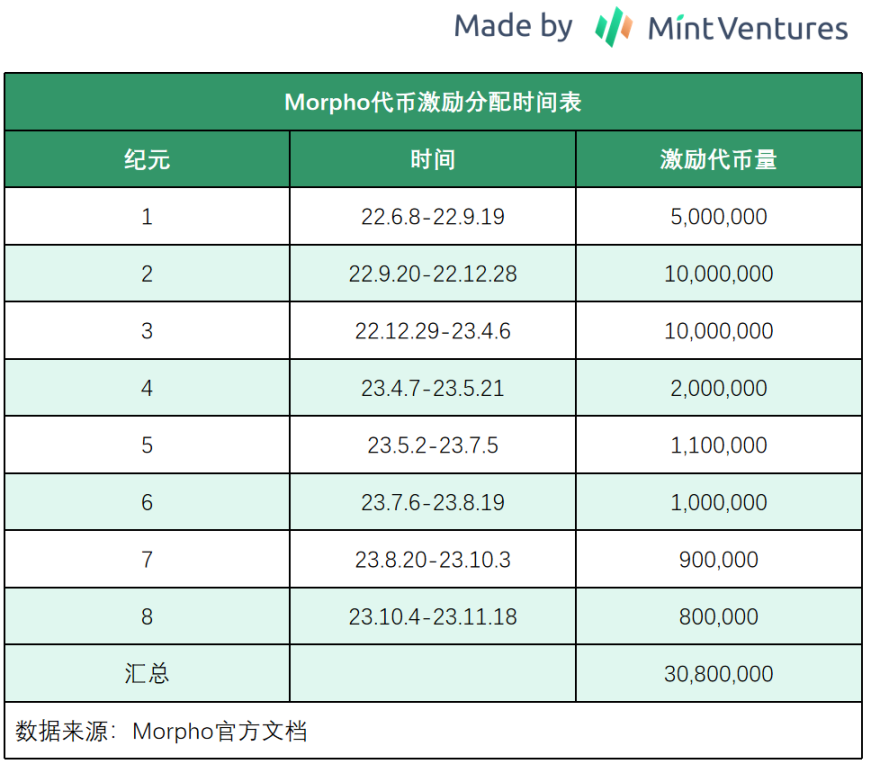
This is a positive signal, indicating that Morpho's product-market fit is quite strong, and the demand from users is becoming more organic. With 51% of the community token allocation still available, there is ample budget space reserved for future business incentives.
However, Morpho currently does not charge for its services.
Team and Financing
The core team of Morpho is from France, with most members based in Paris. The core team members have been identified, and the 3 founders all have backgrounds in the telecommunications and computer industries, with experience in blockchain entrepreneurship and development.
Morpho has undergone two rounds of financing, including a $1.3 million seed round in October 2021, and a $18 million Series A round led by A16z, Nascent, and Variant in July 2022.

Source: Official Website
If the above financing amounts correspond to the officially disclosed 19% investor share, the comprehensive valuation of the project is approximately around $100 million.
Morpho Blue and Its Potential Impact
What is Morpho Blue?
Simply put, Morpho Blue is a permissionless lending base layer. Unlike Aave and Compound, Morpho Blue opens up most lending dimensions, allowing anyone to build a lending market based on Morpho Blue. The dimensions that builders can choose from include:
- What to use as collateral
- What to use as lending assets
- Which oracle to use
- Loan-to-value ratio (LTV) and liquidation threshold (LLTV)
- Interest rate model (IRM)
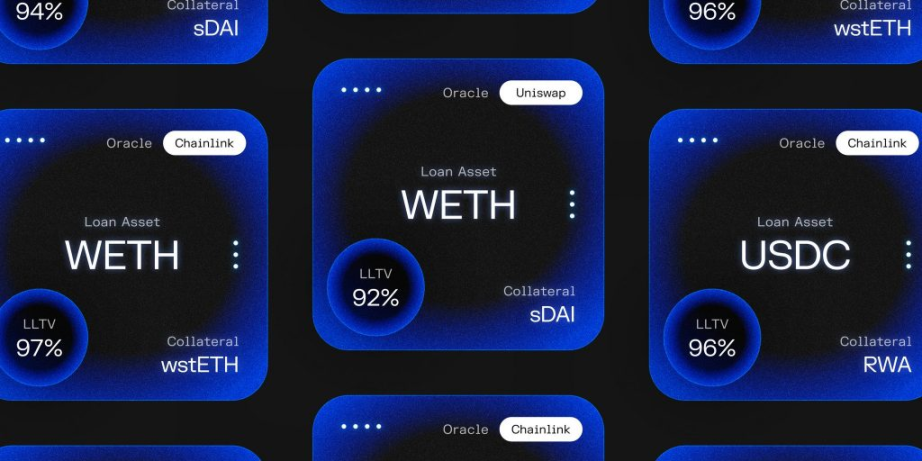
What value does this bring? In the official article, the characteristics of Morpho Blue are summarized as:
Trustless, because:
- Morpho Blue is un-upgradable, and no one can change it, following the minimal governance principle
- It consists of only 650 lines of Solidity code, simple and secure
Efficient, because:
- Users can choose higher LTV and more reasonable interest rates
- The platform does not need to pay for third-party audit and risk management services
- Based on a simple code singleton smart contract (referring to a protocol that uses a single contract to execute, rather than a combination of multiple contracts, similar to Uniswap V4), which significantly reduces gas costs by 70%
Flexible, because:
- Market construction and risk management (oracles, lending parameters) are permissionless and no longer follow a unified model, meaning the entire platform follows a set of standards established by the DAO (Aave and Compound's model)
- Developer-friendly: Introduces various modern smart contract patterns, account management achieves gasless interaction and account abstraction, and free flash loans allow anyone to access assets from all markets with a single call and only need to repay in the same transaction
Morpho Blue adopts a product approach similar to Uni V4, where it only provides a basic layer for a certain type of financial service and opens up the modules above the basic layer, allowing different people to provide services.
Unlike Aave, where anyone can choose what assets to deposit and borrow, the risk control rules are conservative or aggressive, which oracle to use, and how to set interest rates and liquidation parameters, all of which are determined and managed by Aave DAO and various service providers behind the DAO, such as Gaunlet and Chaos, which monitor and manage over 600 risk parameters on a daily basis.
Morpho Blue is like an open lending operating system, where anyone can build their own optimal lending combination on top of Morpho Blue, similar to Aave. Professional risk management organizations like Gaunlet and Chaos can also seek partners in the market to sell their risk management services and receive corresponding fees.
In my view, the core value proposition of Morpho Blue is not just about being trustless, efficient, and flexible, but about providing a free lending market, making it convenient for participants in various stages of the lending market to collaborate and provide richer market choices for customers in each stage.
Will Morpho Blue Pose a Threat to Aave?
Possibly.
Morpho has some differences from many previous Aave challengers, and over the past year, it has accumulated some advantages:
- A total fund management volume of 1 billion, which has reached the same order of magnitude as Aave's 7 billion fund management volume. Although these funds are currently deposited in Morpho's interest rate optimizer, there are many ways to import them into new features
- As the fastest-growing lending protocol in the past year, combined with the fact that its tokens are not officially circulating, there is a lot of room for imagination, making it easy to attract user participation in the launch of new features
- Morpho's token budget is ample and flexible, with the ability to attract users through subsidies in the early stages
- Morpho's stable operating history and fund volume have already accumulated a certain level of brand reputation in terms of security
However, this does not mean that Aave will necessarily be at a disadvantage in future confrontations, as most users may not have the ability and willingness to select services from numerous lending solutions. The lending products output by Aave DAO under its unified management model may ultimately remain the most favored.
Furthermore, the Morpho interest rate optimizer largely inherits the security credibility of Aave and Compound, which allows more funds to gradually feel confident in using it. However, Morpho Blue is a completely new product with standalone code, so institutional investors will inevitably have a period of hesitation before confidently investing. After all, the recent theft incident involving the previous generation's permissionless lending market, such as Euler, is still fresh in memory.
Moreover, Aave has the capability to build a set of features similar to the Morpho interest rate optimizer on its existing platform to meet the demand for improving fund matching efficiency, potentially squeezing Morpho out of the P2P lending market. Although this possibility seems unlikely at the moment, as in July of this year, Aave provided grants to a P2P lending product similar to Morpho called NillaConnect, rather than developing its own.
Lastly, the lending business model adopted by Morpho Blue ultimately does not have any fundamental differences from Aave's existing solutions. Aave also has the capability to observe and emulate successful lending models on Morpho Blue.
However, in any case, after the launch of Morpho Blue, it will provide a more open lending experimental ground, offering the possibility for participation and combination in all stages of lending. Will these newly connected lending clusters produce solutions that are strong enough to challenge Aave? We will have to wait and see.
We await with anticipation.
免责声明:本文章仅代表作者个人观点,不代表本平台的立场和观点。本文章仅供信息分享,不构成对任何人的任何投资建议。用户与作者之间的任何争议,与本平台无关。如网页中刊载的文章或图片涉及侵权,请提供相关的权利证明和身份证明发送邮件到support@aicoin.com,本平台相关工作人员将会进行核查。




